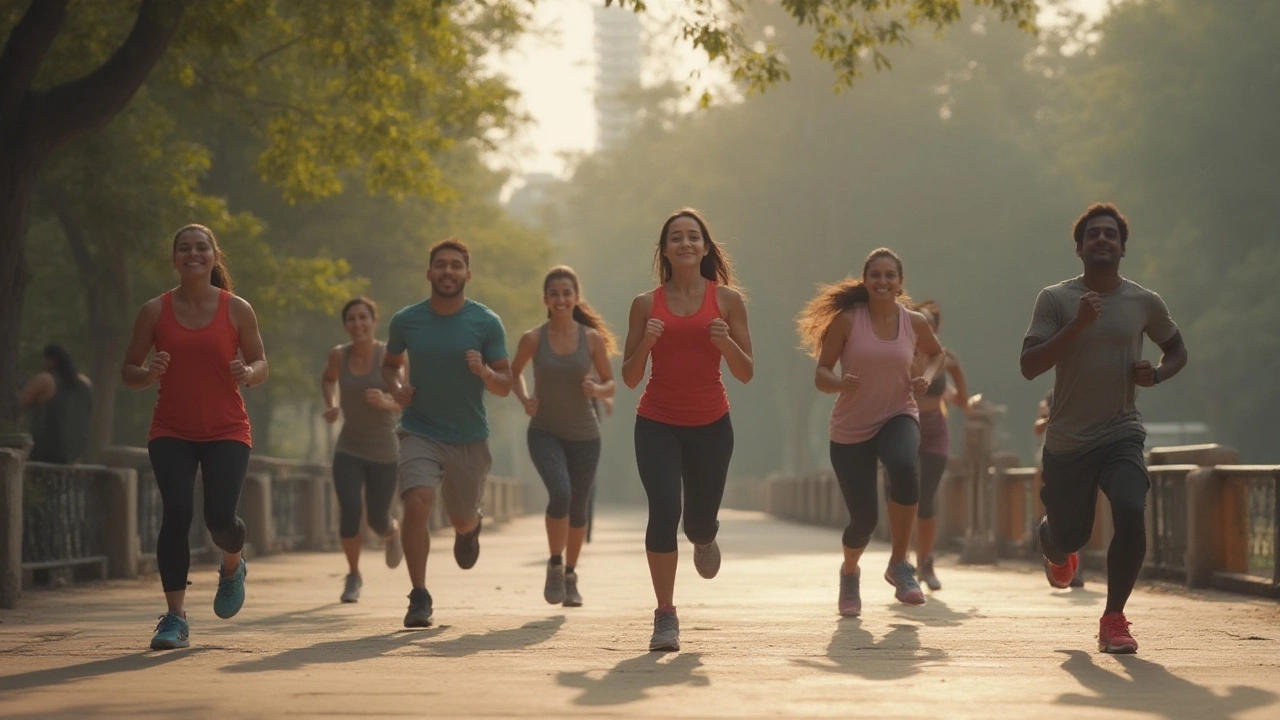
Ever wished you could just snap your fingers and lose 20 pounds right before a big event, a trip to Mallorca, or just to finally get your jeans to fit again? Fast weight loss always sounds tempting. Here’s the reality: it’s totally possible to make significant progress in weeks, but the way most people go about it—starving themselves, butter-in-the-coffee fads—just leaves you burned out or gaining weight back. The trick? Tackling both the mental and physical sides of losing weight with some science-backed hacks and a good dose of straight talk.
The Truth About Rapid Weight Loss and What Actually Works
Saying you want to "drop 20 pounds fast" instantly raises eyebrows from doctors and personal trainers. Why? Because the word "fast" can sometimes mean unhealthy crash diets or crazy water loss schemes. But here’s a surprise: a 2016 study in JAMA showed people who lost weight faster, at the start, often kept more of it off than those who lost slowly, so long as they kept up some lifestyle changes. The catch is, you need to do it safely and set up your habits for long-term wins.
Let’s get real for a second. That “20 pounds” isn’t all fat—dramatic early weight loss is usually a mix of water, glycogen, and a smaller chunk of fat. That's why things slow down after the first week or so. The human body holds about 3 grams of water for every 1 gram of stored carbohydrate, according to the National Institutes of Health. Cut carbs, and you lose water weight… at first. So, if you’re seeing big changes in the first 7 days, it’s often that water dropping away, especially if you switch up your eating habits in a major way.
But don’t get discouraged—real fat loss can and does follow. The trick is making sure you don’t grind yourself into the ground, kill your metabolism, or get snack-crazed. If you do it strategically, losing 2-3 pounds a week (which can add up quick, especially at the start) is actually possible and safe for most healthy adults. If you’re smaller or have a medical condition, you might see a little less, but the main thing is: don’t go hungry or skip meals. Focus on food swaps, clever movement tricks, and mindset hacks to carry you through the rough patches.
Here’s a quick look at what’s happening on the inside when you lose weight:
| Body System | What Changes |
|---|---|
| Metabolism | Can drop with too-low calories; needs movement to stay up |
| Hormones | Hunger hormones may spike; mood hormones change |
| Muscle vs. Fat | Muscle usually goes unless you keep up strength training |
| Water Balance | Lose water first, then fat |
No matter how desperate you feel to speed things up, skipping meals or cutting out entire food groups only makes you miserable and messes with your hormones. A better strategy: flood your meals with protein and veggies, keep carbs to a minimum (for now), drink loads of water, and use exercise to keep your body burning. You don’t have to be perfect. You just have to get it moving in the right direction every single day.
Diet Tricks to Lose 20 Pounds Without Going Hungry
Here’s where most people flub it: they just eat way less and hope for the best. Nine times out of ten, this backfires—few can white-knuckle through constant hunger. For quick and lasting results, the game is high volume and high protein foods that fill you up for as few calories as possible. Think huge salads, big bowls of stir-fried veg, Greek yogurt, big chicken breast, fish. It’s a boring answer, but it works. In fact, a 2020 meta-analysis showed dieters who got at least 30% of their calories from protein lost more weight, and were less likely to lose muscle.
- Protein power: Aim for at least 100–150 grams a day. Think eggs, low-fat dairy, poultry, tofu, fish, and beans. Protein keeps you full, helps maintain your metabolism, and works even when you’re resting. Fancy eating something? Start your meal with grilled chicken or eggs. The rest of the plate will magically shrink.
- Fillers like fibre: Load up on broccoli, spinach, mushrooms, cauliflower, peppers. It sounds basic, but the sheer physical bulk keeps your stomach—and your brain—happy. Fiber slows digestion, so you won’t crash an hour after eating.
- Slash sneaky sugar: Check labels for added sugar, sauces, cereal, protein bars, even seemingly healthy snacks. Replace snacks with nuts, berries, carrots, or a boiled egg. Cravings usually fade once you get sugar out of your system.
- Cut refined carbs—just for now: Bread, pasta, rice, and even oats are easy calories to overeat. Scale way back (try 1 small serving a day, or none for the first two weeks). Replace with more veg or an extra portion of protein.
- Hydrate to fake fullness: Your body can mistake thirst for hunger. Drink water before meals, during, and after. Try seltzer if you hate plain water. Herbal tea works too. If your pee isn’t light yellow, you’re not drinking enough.
Breakfast and lunch should be your biggest meals—don’t skip breakfast, because your body needs fuel to burn fat. A typical fast-track weight loss day might look like eggs and spinach for breakfast, chicken with salad and a drizzle of olive oil for lunch, and white fish with roasted veg for dinner. You can even add a small baked potato or some berries if you have the calories left over. Keep snacks small, and protein-based.
It’s amazing how different you feel after three days on this setup. But heads up: the first few days might suck (headaches, cravings). That’s your body and brain adjusting. Stick with it, and you’ll be surprised how soon things get easier.

Exercise Hacks to Burn More Fat (Without Spending Hours at the Gym)
If you’re dropping 20 pounds, the gym can help—but the real shift often happens outside of it. Walking, brisk stair-climbing, picking up shopping bags, running for the train—these all add up. As for the gym, think short, intense sessions, not marathon treadmill slogs. Here’s why: High-intensity intervals burn more calories in less time and increase the “afterburn effect”—where you keep burning fuel even after you’ve finished working out.
- Interval sprints: Pick any cardio—bike, treadmill, rower, or just running around a park. Go as hard as you can for 30-40 seconds, rest for a minute, then repeat 7-10 times. These can feel brutal, but you’re done in under 20 minutes.
- Strength training: Lifting weights doesn’t just build muscle; it boosts your metabolism, especially if you’re losing weight. Start with full-body moves: squats, lunges, deadlifts, push-ups, and overhead presses. Use moderate weights and go for sets of 12-15 reps.
- Steps matter: Aim for 10,000–15,000 steps a day, even if you spend some time on a treadmill at home. This can be the difference between steady fat loss and a plateau. Use a fitness tracker on your phone if you need some motivation.
- Mix it up: Try boxing, kickboxing, swimming, or even just a brisk walk uphill. Your body likes variety, and mentally, it keeps things fresh.
- Don’t overdo cardio: Too much long, slow cardio can eat into your muscle (which is bad news for your metabolism). Better to do short, hard bursts, a couple of times a week.
If you hate gyms or can’t get to one, bodyweight moves in your living room still work. Ten minutes of bodyweight squats, push-ups, planks, jumping jacks, and mountain climbers is more effective than you think. Trust me—sweat is sweat, and muscle is muscle, whether you got it lifting a dumbbell or your own body.
One smart trick that seems obvious in hindsight: put your big effort workout in the morning. Studies from the University of Northumbria show you burn up to 20% more fat fasted in the AM (but don’t go all day without eating after). Plus, you’re less likely to skip it if you get it out of the way first thing.
Mental Game: Staying Motivated and Making Results Stick
No magic hack works if your head isn’t in the right place. Dropping 20 pounds fast means dealing with temptation, boredom, and your own doubts. The biggest thing: stop aiming for perfection and focus on momentum—doing just a bit better every day. Here are the tricks and facts that actually help people smash their goals:
- Set “micro goals”: Rather than aiming for 20 pounds right off, break it down week by week. Two, three, even five pounds a week at the start is motivating, especially as your body drops initial water weight.
- Weigh yourself twice a week (not daily): Fluctuations drive people crazy. Resist the urge to check daily; pick two consistent mornings a week, before breakfast, and ignore the rest. Check your progress with your belt or favourite shirt—the fit won’t lie.
- Track your food honestly: Write it down. Every bite. Studies show people underestimate calories by 20-40% if they don’t keep notes, especially with snacks and “just a taste.”
- Get public: Tell trusted friends or family for accountability, or use a weight loss support group online. It’s easier to say no to pizza when someone’s rooting for you.
- Don’t beat yourself up: Slip-ups happen. Having a bad meal (or three) doesn’t make you a failure. Get straight back on track at the next meal. Consistency beats perfection, every single time.
Here’s a wild fact: a 2022 study in The Lancet found that people who wrote down their food and activity—even on paper—lost twice as much weight as those who didn’t track it at all. The very act of writing makes you more mindful and, most importantly, honest.
Take before photos—even if you never show another soul. When you start feeling like nothing’s changing, those side-by-sides are the best motivation there is. And remember to treat yourself (just not with food). New socks, a football match ticket—anything that gives you a win.
Last thing: Sustainability is underrated. Build a few non-negotiable good habits (loads of water, veggies at every meal, daily movement) so you never need to do a “fast weight loss” period again. You might be surprised how much of the new routine you want to keep, once you hit your goal.





Rohan Talvani
I am a manufacturing expert with over 15 years of experience in streamlining production processes and enhancing operational efficiency. My work often takes me into the technical nitty-gritty of production, but I have a keen interest in writing about medicine in India—an intersection of tradition and modern practices that captivates me. I strive to incorporate innovative approaches in everything I do, whether in my professional role or as an author. My passion for writing about health topics stems from a strong belief in knowledge sharing and its potential to bring about positive changes.
view all postsWrite a comment